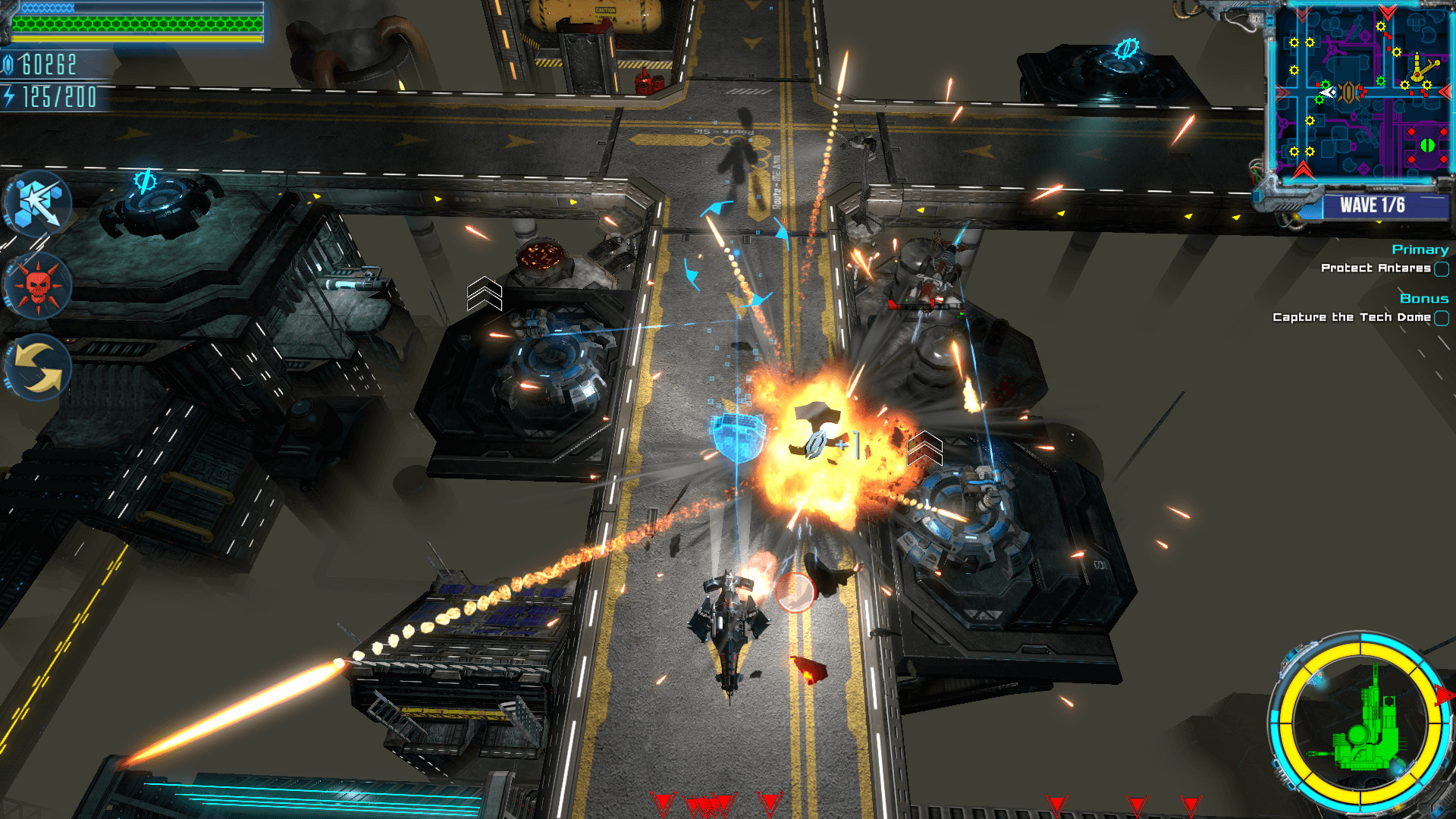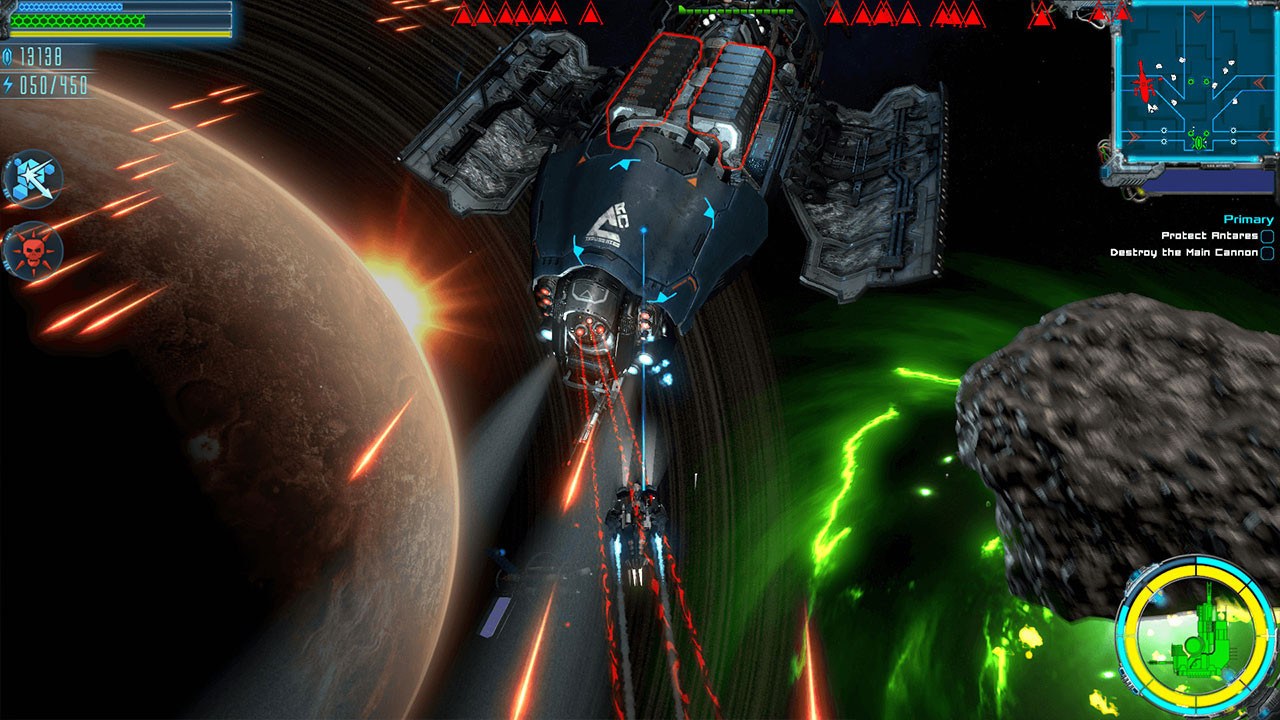Search
[{{{type}}}] {{{reason}}}
{{/data.error.root_cause}}{{{_source.title}}} {{#_source.showPrice}} {{{_source.displayPrice}}} {{/_source.showPrice}}
{{#_source.showLink}} {{/_source.showLink}} {{#_source.showDate}}{{{_source.displayDate}}}
{{/_source.showDate}}{{{_source.description}}}
{{#_source.additionalInfo}}{{#_source.additionalFields}} {{#title}} {{{label}}}: {{{title}}} {{/title}} {{/_source.additionalFields}}
{{/_source.additionalInfo}}- Details
- Category: Computer
- By Sam George
- Hits: 3734
Excubitor (PC)

Excubitor
Developed by: Tesseract Interactive
Published by: Kasedo Games
Release date: May 26, 2016
Available on: Windows, macOS, Linux
Genre: Shoot ‘Em Up, Tower Defense
Number of players: Single player
ESRB Rating: Not rated
Price: $14.99
(Humble Store link)
Thanks, Kasedo Games, for sending us a review key!
Many popular casual games are in the time-management genre. In these games, a hard-working waitress must seat customers, take their orders, and deliver their food in a timely manner. It’s a plate-spinning experience of balancing the growing line of customers at the door with food piling up to be served. Excubitor is, superficially, nothing like that. From moment-to-moment, though, Excubitor feels more like Diner Dash than like other shoot ‘em ups or tower defense games. At the start of each level, you must survey the land, pick a few spots to build turret defenses, and run back to base before the drones that spawned while you were setting up destroy your mothership. While you defend, more drones will spawn across the map to attack helpless colonists. You could fend off the attack now, or wait a few seconds to finish building a weapon-suppressing EMP. Hopefully you set up some generators back at the start, or you’ll be out of power already. This combination of tower defense and shoot ‘em up is a stellar example of neither genre, but the alchemical combination produces intense plate-spinning gameplay of continuous tactical trade-offs and near-failures. In the world of Excubitor, Flo the Diner Dash waitress would be an excellent pilot.
For all I could tell of the plot, Flo might as well be the pilot. I tried to follow the story as told in mission briefings, and I gathered that human colonies set up to mine an energy source known as Voidshards were under attack by drones. I don’t know who the pilot player character is. I don’t know anything about the A.I.-controlled mothership except that it’s called the Antares and must not be allowed to die in any mission. I believe the attacking drones were originally created by humans. Apparently the story didn’t feel the need to explain, because the ending cinematic said that a completely different space ship was investigating the source of the attacks somewhere near Jupiter. I would play a sequel to Excubitor for reasons I’ll get to soon, but the blatant sequel hook is not one of those reasons.
Mission types boil down to defending points, surviving waves, or destroying a boss. The basic mechanics of the game are split between shooting down drones and building towers to shoot them down for you. Shooting them yourself is strongly emphasized. You have few spots to build towers; you must use some spots for power generators; and most of the towers don’t pack enough punch to take out major threats. There are several types of offensive towers such as machine guns, rockets, and multi-shot electric spires. Support towers include enemy-slowing cryo units, EMPs, and ship-healing points. Towers are critical to surviving missions in that they whittle enemy drones’ health so that your ship can take them out quickly.

Strong Points: Fast-paced and constant decision-making; appreciable improvement in leveling and equipment over time; satisfying increase in difficulty from normal to hard and beyond
Weak Points: Limited choice in tower defense gameplay; little visceral appeal in shoot ‘em up gameplay; controls make concessions to tower defense needs at the expense of shooting
Moral Warnings: Space combat with drones, lasers, rockets, and explosions; objective points which may be destroyed include civilian buildings and space ships
The hands-on approach to enemy disposal is facilitated by the same ship which you use to set up towers. The player must switch between construction, attack, and evasion at a moment’s notice. The ship is helped by regular weapon upgrades with good variety. My favorite, albeit inefficient, ship loadout had an ice ray to slow enemies and a flamethrower to provide damage over time. The weapons lack a certain desirable kick and, in my mind, came to be understood as erasers swept over enemies until they disappeared. The ship’s shields, hull integrity, weapon power, and engines can be upgraded over time. Each upgrade is important, and the game is not kind to over-specialization.
You must diversify ship upgrades because, if you don’t, you’ll be too slow to zip about the map efficiently, too squishy to survive waves of enemies, or too wimpy to destroy them before they destroy the mission objectives or your mother ship. Your ship respawns when it is destroyed with no penalty; unfortunately, as long as your ship is down, the enemy can focus all fire on defense points. In this, Excubitor is quite punishing. Sustained fire on objectives over the course of several seconds is devastating. On higher difficulties, a few shots are enough to warrant a retry if they slip by early enough in a mission.
The few enemy types combine in interesting ways to demand tactical responses. Tiny drone swarms can be ignored with the right tower setup and otherwise will annihilate everything. Bombers which will kill the mother ship in moments are slow and, therefore, are escorted by fighters which will deviate from their path to chase your ship. Some drones heal those around them; some drones use tractor beams to prevent your ship from chasing down the bombers. A few enemies become absolute priority targets because of their destructive potential. That said, only one enemy felt unfair to me (I despise the spider tank); the rest were varied and engaging.
Excubitor is a fractal of tactical tradeoffs. Do I need a generator here, or can I afford a rocket tower? Should I defend the secondary objective for the extra reward or rush back to defend the base? Should I try to kill the bomber which is about to end the mission, or do I need to kill the healing drone first? Even power-ups dropped by enemies require careful consideration. The power-ups cycle between various kinds of healing and boosts. Can I grab the speed boost to get to the objective, or do I need to wait for the shield restore? Should I pick up the power-up now or leave it on the map for when I need it more desperately? Whatever the player does, these decisions have to be made fast, because a bomber flanked by fighters is incoming across the map, and it better be stopped. The wrong decisions are punished, so it is very satisfying to successfully balance defense, building, offense, and evasion.

Higher is better
(10/10 is perfect)
Game Score - 82%
Gameplay - 16/20
Graphics - 9/10
Sound - 8/10
Stability - 4/5
Controls - 4/5
Morality Score - 94%
Violence - 7/10
Language - 10/10
Sexual Content - 10/10
Occult/Supernatural - 10/10
Cultural/Moral/Ethical - 10/10
Excubitor should be played with a mouse and keyboard. A controller is well-supported; it just isn’t well-suited to the gameplay. One thumb must be dedicated to movement; the other, to aim. This isn’t a problem in twin-stick shooters because there, “aim” simply means direction. Here, the targeting reticle handles direction as well as distance from the ship, acting as a cursor both to place towers and to attack enemies. A controller is too slow in the heat of battle to handle that kind of precision. The mouse, on the other hand, performs its job very well.
While sound design is fairly minimal, Excubitor distinguished itself with the most helpful and least annoying klaxon I've ever heard. This alarm goes off to signal that a mission-critical point is under attack. Somehow it is just loud enough to be heard over the din of explosions yet quiet enough not to grate. Graphics are good and always make identifying enemies, pickups, and objectives easy. The backgrounds are well-designed as well; unfortunately, each map looks very similar across its surface, making it easy to get lost. The minimap is an essential tool for navigation, and this can be problematic in intense scrambles to and from different points in the level. The low camera angle is more to blame here than the graphics.
The levels full of particles and independent entities can be hard on a computer’s hardware. Slowdown was never a problem; overheating sometimes was. Accompanying overheating were game-breaking loading errors such as spawning the player ship below the plain of the stage or not spawning enemies correctly. Restarting the game, or simply giving my computer a couple minutes to cool off, fixed the problems. The many explosions are the only major moral concern. Robot voices are the primary thing heard in dialog; the rare instance of human voices did not include horrific deaths or terror.
Excubitor, if not more than the sum of its parts, is distinct from them. Arcade combat combined with strategic defense equals frantic time-management. Time flies when you're madly dashing from mother ship to drone factory and back again; I hardly believed Steam when it told me that I'd spent 10 hours on the 16-mission story. Your mileage may vary time-wise. I spent most of the story in Hard mode, finely tuning the first 20 seconds of most levels to get my towers set up before the enemies got too close and iterating on my strategy for the rest of the level until I finally broke through. I wouldn't have it any other way, though Normal difficulty offers a good challenge as well. The game allows difficulty switching during the story. New Game+ mode, then, locks the difficulty on just this side of requiring perfect play. I tried it but did not finish. By that point, Excubitor had given me plenty of thrills and satisfaction. It’s rewarding; it’s fun. It might not be the best choice for fans of Excubitor’s component genres. Nevertheless, its special concoction of tactics is worth trying out.








